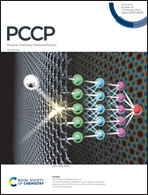Optical properties of thickness-controlled PtSe2 thin films studied via spectroscopic ellipsometry†
Abstract
Platinum diselenide (PtSe2) has attracted huge attention due to its intriguing physical properties for both fundamental research and promising applications in electronics and optoelectronics. Here, we explored the optical properties of chemical vapor deposition-grown PtSe2 thin films with varied thicknesses via spectroscopic ellipsometry. The dielectric function was extracted by using a Lorentz model over the spectral range of 1.25–6.0 eV. We firstly ascribed the resonant energies, extracted from the Lorentz model, to different interband electronic transitions between valence bands and conduction bands in the Brillouin zone. A predicted exciton is observed at 2.18 eV for the monolayer and the corresponding exciton binding energy is 0.65 eV, in line with previous theoretical calculation and the measured absorption spectra. Additionally, the exciton peak shows a red shift with the increase of thickness, which is the consequence of strong interlayer interaction. These results enrich the fundamental understanding of PtSe2 and are conducive to its potential applications.



 Please wait while we load your content...
Please wait while we load your content...